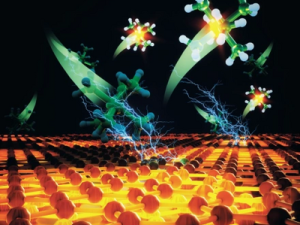

Research Bio
Research efforts in the Bediako Group involve the mesoscopic investigation of interfacial charge transfer and charge transport in two-dimensional (2D) materials and heterostructures. We emphasize the design of materials with modular interfaces that can be controlled at atomically precise length scales to study and overcome contemporary challenges in electrochemical energy conversion and quantum electronics.
Our group synthesizes and isolates atomically thin inorganic crystals, deterministically assembles these 2D layers into novel multicomponent materials, and quantitatively interrogates the discrete architectures as constituents of electrochemical and electronic devices. To achieve our goals, we leverage solid-state and solution-phase methodologies, as well as chemical and electrochemical deposition techniques for materials synthesis. We use state-of-the-art micromanipulation and nanofabrication tools for the preparation of mesoscopic structures, and employ a range of optical spectroscopy, scanning-electrochemical, electron microscopy, and low-temperature quantum magnetotransport probes to measure the (electro)chemical and physical properties at individual devices.
Research Expertise and Interest
inorganic chemistry, materials chemistry, heterogeneous catalysis, electrochemistry, quantum transport, optoelectronics, low-dimensional and nanoscale structures



